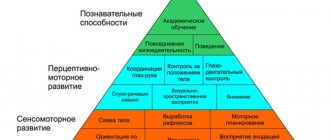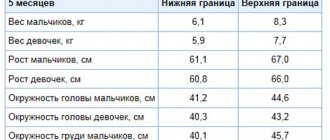The material in this and subsequent articles on the development of a child in the first year of life will be of interest to those parents who want to take responsibility for the health of their baby.
From the moment a baby appears in your family, you will probably come across the opinion that only specialists (pediatricians, child neurologists and orthopedists) can determine how healthy and developed your child is, only a professional massage therapist can do massage and gymnastics correctly, only an instructor in swimming will be able to practice early swimming with him.
I believe that in the event of the birth of a healthy child, it is enough for his mother to have good information about child development and about different methods of teaching a newborn, as well as the desire to master them herself and apply them in practice. And for a baby there is nothing better than a mother’s hands and voice addressed to him with love. In the case of the birth of a sick child, professional treatment is, of course, necessary, but the active involvement of parents in the healing process is also necessary.
This material is about the development of a healthy baby and what parents can do with their baby to help this development.
What does a newborn look like?
So, before us is a newborn baby - in the first 6 weeks of life . Let's look at what he looks like lying on his back, on his stomach and in an upright position.
Supine position
The child's posture is unbalanced; you see that he moves his head, arms and legs chaotically. At the same time, the hands are clenched into fists, the arms are bent at the elbows, and the legs are spread outward. The baby's head does not stay in the middle position, turning without preference either to the left or to the right. If you put your thumbs in your baby's hands, he will squeeze them. Holding his forearms with your hands, lift the child slightly above the surface, you will see that his head will tilt back.
Prone position
A healthy newborn turns his head to the side (with a one-way light source, mainly in one direction) and can lift it sideways for a moment. The arms and legs are completely bent, the hands are clenched into a fist, the knees are pulled under the stomach.
If the baby does not remain in a resting position, then reflexive crawling movements are visible. An adult can cause such movements by lightly pressing the thumb on the foot. This leads to extension of the legs and movement of the body forward. Try stimulating your left and your right foot alternately and evaluate the same force of reaction on both sides.
These photos clearly show how our children have grown up and learned a lot: they lie confidently on their backs, the movements of their arms and legs are no longer chaotic. Babies begin to learn coordinated movements: hand-mouth, hand-foot.
Vertical position
Hold your baby under the armpits with both hands and position him upright, allowing his feet to touch the surface. At the same time, support the head with your thumbs in the middle position, turn the child’s back towards you. A healthy newborn in this position demonstrates a “primitive leg support response.” The legs of a vertically held baby straighten, the tone of the knee joints increases, and to a lesser extent the hip joints; straightening of the whole body and a short raising of the head are possible. The entire foot touches the surface, the arms are bent, the palms are clenched into a fist.
If you tilt the child’s torso slightly forward, you can observe an “automatic stepping movement” - the baby will alternately perform stepping movements with his legs.
This is what a healthy baby looks like during the first 6 weeks of life. In the future, it will develop thanks to the program invested in it by nature itself. The main task of the first three months, if you remember (if not, look at the article Motor development of a child in the first year), is mastering a new environment, which is completely different from the space of the uterus in which the baby developed over the previous 9 months. Each child is unique, so the pace of achieving this goal will naturally vary. However, keep in mind that the next approximate time point when you should evaluate the development of your child is 3-3.5 months.
The main causes of hypotension
With this disease, the baby cannot hold its arms and legs in a tense state for a long time. It is difficult for such babies to learn to crawl, grab toys, and hold their heads upright. It is difficult for them to sit upright and they start walking late. At what months do children start walking, read here.
Decreased muscle tone in a baby may appear immediately after birth, but such manifestations can be diagnosed several months later . Directly related to the central nervous system, muscle weakness syndrome is caused by a number of factors.
Smoking during pregnancy leads to oxygen starvation of the child and neurological problems, including hypotension
Provoke the development of the disease:
- Complications of diseases of the expectant mother during pregnancy.
- Difficult or emergency labor.
- Maternal abuse of smoking or alcohol, disordered lifestyle.
Some of the most common causes of weak muscle tone in a baby include:
- violations in the organization of infant nutrition;
- low baby weight at birth;
- congenital diseases;
- significant weight loss by the infant after viral and infectious diseases;
- taking vitamin D in large doses;
- various malformations of the baby, leading to pathological changes.
Hypotonia in an infant can develop against the background of diseases such as polio, botulism, congenital myopathy or muscle atrophy.
Characteristic manifestations of disturbances in normal muscle activity allow early detection of muscle weakness:
1 First of all, this is the relaxed state of the newborn, who lies in a calm position, with open palms.
2 The position of the legs of a baby with weak muscles when lying down, amounting to 180°, is quite comfortable for the baby.
3 During breastfeeding, such a baby may often fall asleep, and the feeding process is very sluggish.
4 Underdeveloped chest muscles negatively affect the strength of sounds produced. When a child begins to coo, read here.
5 Frequent dislocations of joints with this disease are not uncommon.
6 Decreased reflexes also indicate muscle hypotonicity.
7 In severe cases, the infant experiences heavy intermittent breathing, a drooping lower jaw, and tongue prolapse.
8 Signs of hypotension in a baby are its appearance. Such a baby constantly throws his head back, forward or in different directions, without the strength to hold it straight. For support, the baby uses his elbows and knees, only slightly spaced in different directions.
The head of the department for newborns at the Obstetrics and Gynecology Clinic named after A. V.F.Snegireva O.V.Parshikova in the video:
Hypotonia in infants is not considered a life-threatening disease . However, the consequences of the disease, if not treated promptly, can become serious:
- Violation of the normal development of motor skills leads to a lag behind their peers in physical development.
- Weakening of the ligamentous apparatus leads to damage to the ankle, knee, hip and other joints.
- In difficult cases, the baby cannot chew and swallow food on its own. Then he is fed through a tube or parenterally.
- In the future, the child experiences a curvature of the spine, which leads to poor posture and scoliosis.
- Muscle hypotonia in a baby in infancy leads to a severe weakening of the musculoskeletal system and the likelihood of developing complete muscle dystrophy.
When the first signs appear, you should consult a neurologist. The doctor’s conclusion about the condition of the newborn is made after performing some simple manipulations.
| Name of manipulation | Normal reaction | Reaction to violations |
| Lay the baby on his back and pull the arms | When you try to sit the baby down, he resists | There is no resistance, the child hangs in the doctor’s arms, and the head tilts back |
| The baby is supported and lowered onto a firm support (up to 2 months of age) | He straightens up and tries to stand on his full foot. | The child strives to immediately sit on bent legs |
| Reflexes for horizontal and vertical suspension are tested | The child holds his head straight in a vertical position, and in a horizontal position the limbs are bent at the joints, the back and head are held straight | The head and legs hang down, and the child slips out of the doctor's hands. The baby hangs its limbs and head, resembling an inverted letter U |
To clarify the cause of the disease, the following is carried out:
- Magnetic resonance imaging;
- electromyography and neurosonography;
- cerebral blood flow study;
- laboratory blood tests (complete blood count, biochemical);
- biopsy of muscle tissue of affected nerve fibers;
- genetic research.
Khadzegova S.R., pediatrician, candidate of medical sciences, City Clinical Hospital No. 33, city of Maria
Weakened muscles in an infant may indicate the possibility of developing serious diseases related to the brain, so you should not self-medicate. At the first signs of illness, you should immediately run to your doctor.
The local pediatrician writes out referrals to a neurologist and other specialists, and prescribes laboratory tests to determine the causes of the pathology.
The peripheral nerve, cerebellum, and peripheral motor neuron are examined. Such complex studies are carried out in order to exclude the presence of a more complex disease.
Diagnosis must be carried out comprehensively: by a therapist, cardiologist, neurologist, geneticist and pediatric physiotherapist.
If other diseases are excluded, treatment of muscle hypotonicity in children is aimed at restoring normal muscle function.
Massage for hypotonicity - stimulating, consisting of strong pressure, kneading, pinching
The main therapy for infants is massage, which has a stimulating effect . Physiotherapeutic techniques, and primarily electrophoresis and magnetic therapy, painlessly help to normalize the response of muscle fibers to a nerve impulse.
Exposure to electric and magnetic fields normalizes metabolism, increases blood flow and reduces inflammatory processes. The use of electrophoresis in conjunction with pharmacological drugs greatly enhances the effect of treatment. Good results are also achieved by using acupuncture, a complex of physical therapy, and aromatherapy.
Depending on the underlying cause, drug treatment is prescribed when treating muscle hypotonicity in infants. These can be drugs from the group of antioxidants, neuproprotectors and muscle relaxants. Highly qualified medical personnel and doctors with Ph.D. degrees prescribe gentle treatment based on the individual characteristics of the baby’s development.
Melnikova I.V., exercise therapy doctor, trainer-teacher, exercise therapy instructor, massage therapist, GBDOU “Correctional Kindergarten”, St. Petersburg
Muscle dystonia in infants can be eliminated with the help of a good massage therapist. I advise you to contact a traditional medicine clinic about this issue. They give excellent massage here, and treatment is carried out only with natural preparations.
Complex treatment without the use of medications allows you to cope with the problem in a short time.
What does a healthy baby look like at 3-4 months of age?
Supine position
The child lies straight on his back, quite confidently. The head, torso and butt are pressed to the surface. The hands are raised, the baby plays with them, holding them in front of his face, examines them and pulls them into his mouth. The legs, bent at the hips and knees, are also raised above the body, spread to the sides, feet raised in the air. Hands and feet learn to grasp. If you place your thumbs in the child’s palms, and with the rest clasp the ends of his forearms and try to slowly lift him, you will see that he holds his head for at least 2 seconds without throwing it back.
Prone position
The child lies confidently on his stomach, resting on his pelvis and supporting himself with his elbows, placed slightly to the sides, shoulder-width apart. Leaning on the forearms, the baby can freely hold his head straight and turn left and right. Already at this stage of development, the child is trying to straighten up and rise. Although the stomach is still completely on the surface, the chest is already slightly raised. The child's legs are spread apart, the knees are turned outward, and the legs are slightly bent at the knee joints. The feet touch each other in the air, and the child can play with them.
Vertical position
In this position, oddly enough, it may seem that your baby not only has not moved forward, but has even lost the skill of supporting and walking. After all, everyone understands that by the age of one year a child should stand firmly on his feet and try to walk. Your baby at the age of 3-4 months will not rest on his feet, will begin to draw his legs in and will stop taking steps. This is explained simply. A newborn rests on his foot and walks only thanks to the innate reflexes of “support” and “automatic gait”. Now these reflexes, as expected, have faded away. The time will come, and the baby will master the necessary skills, but for now he demonstrates their absence, and this is normal.
Now let us dwell on those points that should attract attention and encourage parents to seek advice from a specialist when assessing a child aged 3-4 months:
- The baby, lying on his stomach, constantly cries or rolls over onto his back.
- The baby in the position on the stomach or on the back is clearly not symmetrical. In other words, the line mentally drawn along the center of his torso noticeably shifts to one side or is completely curved.
- The baby prefers to sleep on the same side all the time. Normally, during sleep, the child places his head equally well on the left and right sides. The baby should not give preference to any one side, as this can lead to curvature of the head bones.
- The folds on both legs of the baby are not the same (asymmetrical).
- The hip extension in different directions is not the same.
This photo clearly shows that the child’s body is symmetrical. The buttock folds and folds on the legs are symmetrical.
Correcting muscle weakness in a child using massage
If hypotension is detected in an infant, it is recommended that a massage be performed by a specialist. A professional massage will give the best results, and a pediatric specialist will be able to perform it safely. The baby's skin is very delicate, and movements should be quite sharp and intense.
The massage therapist, lightly pressing on individual areas of the muscles, also performs acupressure massage of bioactive points. To achieve a positive result, at least 10 sessions are required .
Massage for hypotension can be performed at home. The main techniques are general strengthening exercises and individual exercises for the limbs. General strengthening exercises include:
- “Lulechka.” During this exercise, with smooth movements, placed under the head and torso, in the upper and then in the lower parts, the baby is rocked in all directions.
- The “Rock” exercise, when the child is gently rocked under the arms, has a general strengthening effect.
- An effective technique is squeezing the baby's arms and legs and lightly stroking the limbs.
After watching a video of massage for hypotonicity in infants, do not try to learn how to do the exercises as well as a professional children's massage therapist. At home, it is recommended to carry out only restorative massage:
Dr. Komarovsky believes that muscular dystonia in infants should be eliminated with the help of a good massage therapist . But some special gymnastic exercises for the limbs can also be performed at home by the mother herself.
Professional massage for hypotension makes the child’s muscles work and become stronger
Komarovsky recommends regularly repeating these exercises for hypotonia in infants. The series of exercises includes:
- alternately spreading and bringing together arms and legs;
- imitation of a boxer's movements with the baby's hands;
- movement as when riding a bicycle with both legs;
- stretching the arms up above the body as high as possible.
Exercises with a large rubber ball (fitball) are also effective:
- Place the child's back on the ball and, holding the stomach, move up and down.
- Place the baby on the ball, holding it tightly, and make bouncing movements.
- Place the baby's stomach on the ball and roll it around. The exercise is repeated until he learns to pull his legs up when touching the floor.
A good way to combat the disease is aqua gymnastics. Activities in the pool, which babies really like, are conducted by a doctor. At home, in the bath, you can repeat the simplest exercises. It is also useful to develop fine motor skills in infants with the help of toys .
The main method for preventing muscle hypotonia in newborns is a healthy pregnancy. Complete abandonment of bad habits, a healthy balanced diet, and constant monitoring by doctors will ensure the normal development of the child in the womb . Even minor signs indicating muscle flaccidity cannot be ignored. With timely initiation of treatment, the pathology is easily eliminated and does not leave consequences in the development of the child.
Zhukova O.V., pediatrician, Children's Doctor Clinic, Voronezh
For any baby, especially in the first months of life, proper nutrition is very important, especially during treatment.
The menu drawn up by the doctor, which guarantees that the baby receives all the necessary nutrients, must be strictly followed.
Psychotherapy is also an important part of the treatment process.
How to check hip mobility?
Here it is worth describing in more detail how to check hip mobility. Place your baby on his stomach. With one hand, press your baby's butt, with the other hand, grab his right knee, bend his leg at the hip and turn his knee to the right side. This bending should be done with ease, without feeling resistance in the hip joint, and the butt should not move upward. Repeat the hip flexion and extension to the left side and compare your sensations. Both hips should move equally well.
Turn the baby over onto his back and spread his legs out to the sides again. Pay attention to whether such dilution occurs equally easily on both sides.
In conclusion, I would like to note that if your baby was born prematurely or his birth was associated with any injuries, then his development, with good reason, may be slightly slowed down. That is why experts give such children a head start of 1.5 months, which means they need to be assessed with passion at the age of 4.5-5 months.
In the next article, you will receive specific recommendations for the first three months of a child’s life, using which you can help him develop successfully.
Popular









